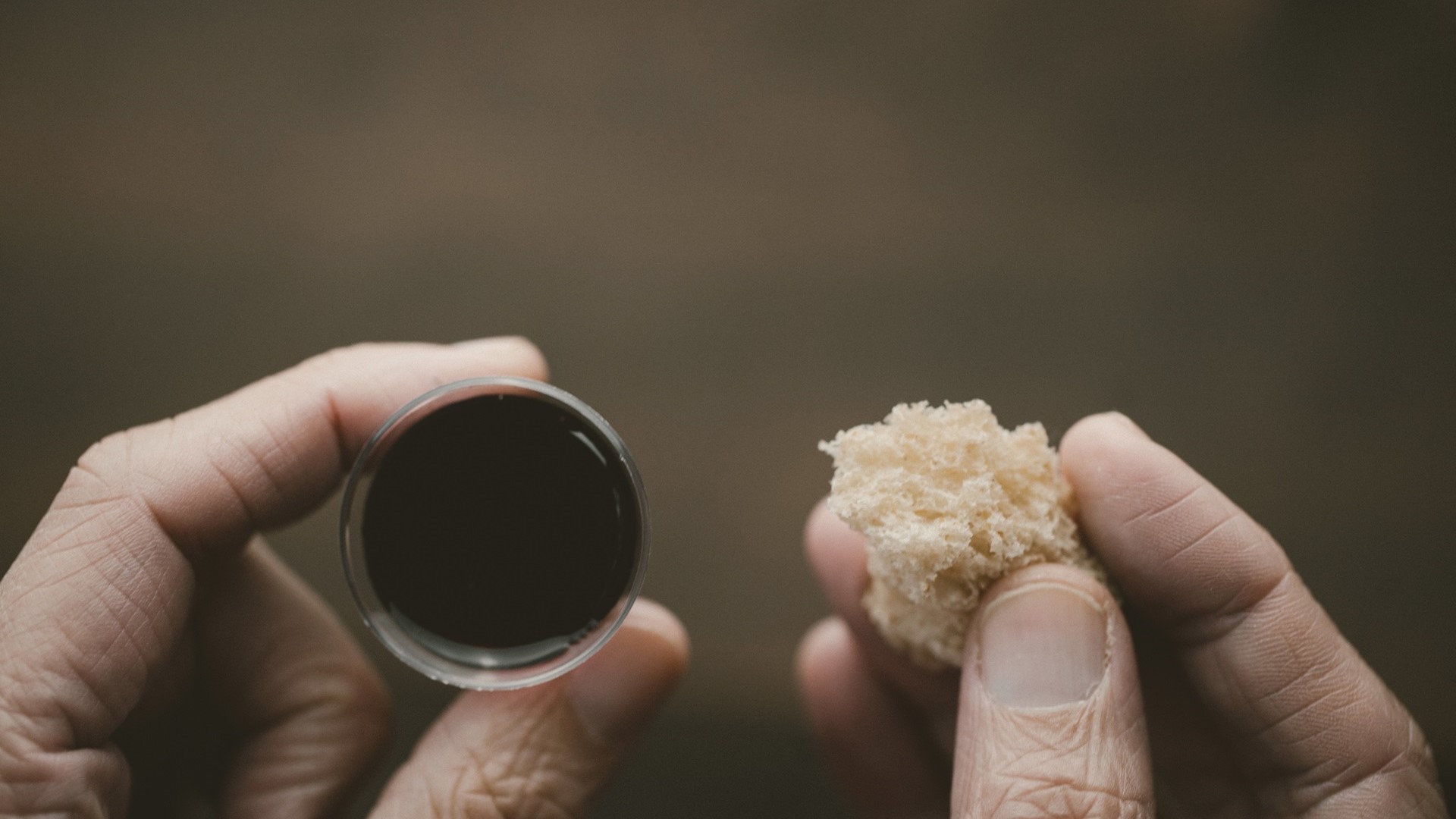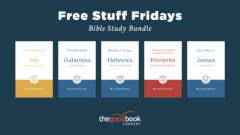One great benefit of having an evening service is that it provides opportunities that aren’t with just one weekly meeting. At Grace Fellowship Church we have a “standard” evening service that accomplishes a number of purposes, but sometimes we also mix it up. Last week we dedicated the entire service to an “explanatory Lord’s Supper.” In other words, we not only celebrated the Lord’s Supper, but we also explained each part of the service to ensure our members do not only know what we do, but also why we do it. Here’s how that evening unfolded under the leadership of Pastor Paul (the senior pastor). Words in italics are the explanatory portions that were read out while the non-italics describe the actual service.
The Invitation
The service begins with an invitation to every Christian to come to the table.
Friends, tonight we have the great joy of approaching God through one of the two ordinances that He established for His people: the Lord’s Supper. This very simple, symbolic meal is where every Christian should come and meet with God in order to remember what Jesus did for them on His cross. Hear the invitation of Jesus to you: “Come to me, all who labor and are heavy laden, and I will give you rest. Take my yoke upon you, and learn from me, for I am gentle and lowly in heart, and you will find rest for your souls. For my yoke is easy, and my burden is light” (Matthew 11:28–30).
The Warning
This general invitation is followed by warnings: a warning to Christians to not approach the table sinfully, and a warning to those who are not yet Christians to be observers only, not participants.
To those of you who are already Christians, especially those of you who are members of this church, the Bible teaches that this remembrance is open to all Christians. It is open to all men and women who have repented of their sins and put their trust in the Lord Jesus Christ for salvation.
The Bible also clearly teaches that before eating and drinking, the believer must properly examine himself. This includes careful self-inspection (comparing what we are to what we ought to be) and careful table-inspection (contemplating the body and blood of Jesus that the bread and cup symbolize, remembering His sacrifice and rejoicing in His provision). We will do these two things in a few moments.
If you are a Christian and are willing to participate in this careful inspection, I invite you to “meet Christ” at His table tonight. If you have truly put your faith in the good news of the gospel, then this Lord’s Supper table is for you.
There are some people who should not eat and drink with us tonight. The primary reason is that they will be adding to their guilt before God. One of the key claims we make in this meal is that we belong to Jesus–that our salvation depends on Him alone., that He is our only hope, and that He is our personal Saviour. The meal symbolizes these things, so it would be disingenuous, if not something close to mockery of God, to eat and drink the symbols if there is no reality behind them.
So, those who know they are not a Christian; who are unsure of their conversion; who are children incapable of understanding the significance of the ordinance; or who claim to be Christians, yet are walking in open rebellion against God by refusing to stop sinning—these people must not take the bread and cup when they are passed among the congregation so as to not “eat and drink judgment on themselves.”
We do, however, want you to stay and watch, for there is much to learn here, and many wonderful things to hear! And our prayer for you is that as you look and listen, God will open your heart to receive Jesus Christ as your Saviour, too. Nothing would make us happier for you.
Scripture Reading
It is our desire to do all that God commands, and only what God commands. So, we root our actions in His Word, the Bible. At this part of our service we read two texts that inform us of what we should do.
The Lord’s Supper did not appear out of thin air. It has its roots in the first Passover meal, when God spared the firstborn of Israel by killed the firstborn of the Egyptians in the tenth and final plague. The Hebrew firstborn were replaced by a sacrificed lamb. The Passover meal was to be a commemoration of this salvation and of God delivering His people out of slavery. So, we read that account to root our actions in their foundation.
Then Moses called all the elders of Israel and said to them, “Go and select lambs for yourselves according to your clans, and kill the Passover lamb. Take a bunch of hyssop and dip it in the blood that is in the basin, and touch the lintel and the two doorposts with the blood that is in the basin. None of you shall go out of the door of his house until the morning. For the LORD will pass through to strike the Egyptians, and when he sees the blood on the lintel and on the two doorposts, the LORD will pass over the door and will not allow the destroyer to enter your houses to strike you. You shall observe this rite as a statute for you and for your sons forever. And when you come to the land that the LORD will give you, as he has promised, you shall keep this service. And when your children say to you, ‘What do you mean by this service?’ you shall say, ‘It is the sacrifice of the LORD’s Passover, for he passed over the houses of the people of Israel in Egypt, when he struck the Egyptians but spared our houses.’” And the people bowed their heads and worshiped. Then the people of Israel went and did so; as the LORD had commanded Moses and Aaron, so they did.
Exodus 12:21–28
Jesus was in the midst of celebrating the Passover supper when transformed it into something new: The Lord’s Supper, the commemoration of another Lamb who was killed in the place of His people. This is the celebration of a greater salvation! Listen as I read from Matthew’s Gospel:
When Jesus had finished all these sayings, he said to his disciples, ‘You know that after two days the Passover is coming, and the Son of Man will be delivered up to be crucified.’ (Matthew 26:1–2)
Now on the first day of Unleavened Bread the disciples came to Jesus, saying, ‘Where will you have us prepare for you to eat the Passover?’ He said, ‘Go into the city to a certain man and say to him, ‘The Teacher says, My time is at hand. I will keep the Passover at your house with my disciples.” And the disciples did as Jesus had directed them, and they prepared the Passover. (Matthew 26:17–19)
Now as they were eating, Jesus took bread, and after blessing it broke it and gave it to the disciples, and said, “Take, eat; this is my body.” And he took a cup, and when he had given thanks he gave it to them, saying, “Drink of it, all of you, for this is my blood of the covenant, which is poured out for many for the forgiveness of sins. I tell you I will not drink again of this fruit of the vine until that day when I drink it new with you in my Father’s kingdom.” And when they had sung a hymn, they went out to the Mount of Olives. (Matthew 26:26–30)
Prayer
We pause here to pray and ask God to help us remember Jesus in the way that He told us to.
So Lord, grant us eyes to see, ears to hear and minds to conceive all that you have done for us in Christ. Scrub away all our wrong ideas. Install truth where there was ignorance. Make us remember Jesus, our Passover Lamb, tonight. Amen.
The Affirmation of Faith
Because the Lord’s Supper is a church meal, we desire to testify to each other what we believe, what we all hold to be true. There are many things about which we hold different preferences, but there are some facts that must be believed in order to be a Christian. This time of affirmation is meant to remind us of those and to strengthen our faith.
Tonight’s Affirmation of Faith is the Apostle’s Creed. Let’s read it out loud to one another.
I believe in God the Father Almighty, Maker of heaven and earth:
And in Jesus Christ his only Son, our Lord;
who was conceived by the Holy Spirit,
born of the virgin Mary,
suffered under Pontius Pilate,
was crucified, dead, and buried;
the third day he rose again from the dead;
he ascended into heaven,
and sits at the right hand of God the Father Almighty;
from there he shall come to judge the living and the dead.
I believe in the Holy Spirit;
the holy catholic church;
the communion of saints;
the forgiveness of sins;
the resurrection of the body;
and the life everlasting. Amen.
Singing
The first celebration of the Lord’s Supper included the singing of at least one hymn. So, it is our joy to sing together as we move through this service, testifying in song to the realities of Christ’s death and resurrection.
“Jesus Paid It All”
Membership Covenant Reaffirmation
Participation in the Lord’s Supper does not stand alone in the Christian experience, but usually follows in this way: Conversion, baptism, local church membership, then the Lord’s Supper. This is because we are enjoying a communal meal and the emphasis is not on our own personal experience, but rather in our church family sitting down with Jesus at His table. To remind us of our bonds of love to one another, we read our membership covenant out loud together.
[Read the membership covenant]
Self-Inspection (Confession of Sin)
Since it is Christ’s table and He sees the secret as well as the obvious sins of our lives, it is necessary that we pause to confess our sins. This is part of our self-inspection. Sometimes we do this silently and privately and sometimes we do this aloud and publicly.
“Let a person examine himself, then, and so eat of the bread and drink of the cup.”
Since we just read the Membership Covenant, take a moment to ponder it again. As we go to prayer now, let’s confess where we have specifically failed to keep the covenant. Pray aloud in short prayers that begin with: “Lord, forgive me for ________.”
Table Inspection (Understanding the Holy Purpose)
Not only do we need to look inside, but we also need to look outside. The symbols on this table are meant to remind and teach us.
Jesus said: “This is my body, which is for you. Do this in remembrance of me.” We are to ponder the fact that Jesus Christ took on human flesh and died a real death in a real body in our place. He also said: “This cup is the new covenant in my blood. Do this, as often as you drink it, in remembrance of me.” We are to ponder the fact that just as an unblemished lamb had to die in the Passover, so our sinless substitute, Jesus Christ, the Lamb of God who takes away the sins of the world, had to die as our substitute. Pondering His body and blood ought give us great comfort!
As we go to prayer now, let’s glory in what this bread and cup represent! Let’s pray aloud again, this time beginning with “Lord, we praise you for________.”
Singing
“There is a Fountain”
Distribution
It is our custom to give out bread, then all eat together. Then we give out the cup and drink all at the same time. This eating together is significant to us because it signifies our unity with one other and ensures none of us are plowing ahead unconcerned for those around us. Paul speaks to this unity in his first letter to the Corinthians: “But in the following instructions I do not commend you, because when you come together it is not for the better but for the worse. For, in the first place, when you come together as a church, I hear that there are divisions among you. And I believe it in part, for there must be factions among you in order that those who are genuine among you may be recognized. When you come together, it is not the Lord’s supper that you eat. For in eating, each one goes ahead with his own meal. One goes hungry, another gets drunk. What! Do you not have houses to eat and drink in? Or do you despise the church of God and humiliate those who have nothing? What shall I say to you? Shall I commend you in this? No, I will not.” (1 Corinthians 11:17–22)
Tonight, however, we will do one thing differently specifically to highlight what is merely one of this congregation’s traditions and not something based on clear biblical example. We will pass the bread first and you keep it. Then we will pass the cup. Hold on to that, also. Then, once everyone has both, we will eat and drink together. We are doing it this way to shake things up a bit to make sure we are emphasizing what the Bible emphasizes: remembering Christ together.
An elder thanks God for the bread and another elder thanks God for the cup, again reminding us of how much God loves us as seen in the atoning work of His Son.
[Two of our elders prayed, one for the bread and one for the cup. They then distributed the elements while we sang.]
“When I Survey the Wondrous Cross”
Eating & Drinking
Now that we hold these symbols of Christ’s body and blood in our hands, we will take them together…
The Bread: “For I received from the Lord what I also delivered to you, that the Lord Jesus on the night when he was betrayed took bread, and when he had given thanks, he broke it, and said, ‘This is my body, which is for you. Do this in remembrance of me.’” Let us remember our Lord, together.
The cup. “In the same way also he took the cup, after supper, saying, ‘This cup is the new covenant in my blood. Do this, as often as you drink it, in remembrance of me.’” (1 Corinthians 11:23–26) Let us remember our Lord, together.
Words of Assurance
Having searched our hearts, recalled Christ’s sacrifice and identified with Him afresh, we take courage from His Word and glory in what He has done for us. “For as often as you eat this bread and drink the cup, you proclaim the Lord’s death until he comes.” It is this death that is our life.
“If we say we have no sin, we deceive ourselves, and the truth is not in us. If we confess our sins, he is faithful and just to forgive us our sins and to cleanse us from all unrighteousness” (1 John 1:8–9).
“But God shows his love for us in that while we were still sinners, Christ died for us. Since, therefore, we have now been justified by his blood, much more shall we be saved by him from the wrath of God” (Romans 5:8–9).
“For I am sure that neither death nor life, nor angels nor rulers, nor things present nor things to come, nor powers, nor height nor depth, nor anything else in all creation, will be able to separate us from the love of God in Christ Jesus our Lord” (Romans 8:38–39).
“And he who was seated on the throne said, ‘Behold, I am making all things new.” Also he said, “Write this down, for these words are trustworthy and true.’ And he said to me, “It is done! I am the Alpha and the Omega, the beginning and the end. To the thirsty I will give from the spring of the water of life without payment. The one who conquers will have this heritage, and I will be his God and he will be my son” (Revelation 21:5–7).
Prayers of Thanksgiving
The proper response to the Gospel is always repentance, belief and worshipful thanksgiving. Our service draws near its end with prayers of thanks to God for what He has done for us in Christ.
Several of you lead us in prayers of thanksgiving to God.
Singing
“Take My Life and Let it Be”
Commission
We prepare to leave this place being sent out by the grace of God as contained in His Word.
“What then? Are we to sin because we are not under law but under grace? By no means! Do you not know that if you present yourselves to anyone as obedient slaves, you are slaves of the one whom you obey, either of sin, which leads to death, or of obedience, which leads to righteousness? But thanks be to God, that you who were once slaves of sin have become obedient from the heart to the standard of teaching to which you were committed, and, having been set free from sin, have become slaves of righteousness. I am speaking in human terms, because of your natural limitations. For just as you once presented your members as slaves to impurity and to lawlessness leading to more lawlessness, so now present your members as slaves to righteousness leading to sanctification” (Romans 6:15–19).
Blessing
Having been refreshed by this means of grace, we leave with the blessing of God on our heads. Tonight’s benediction comes from Hebrews 13.
Now may the God of peace
who brought again from the dead our Lord Jesus,
the great shepherd of the sheep,
by the blood of the eternal covenant,
equip you with everything good that you may do his will,
working in us that which is pleasing in his sight,
through Jesus Christ,
to whom be glory
forever and ever.
Amen.










